The Trust offers financial assistance to individuals or groups to carry through restoration or improvement projects to completion. The Trust also invites enquiries about sponsoring one or more Awards.
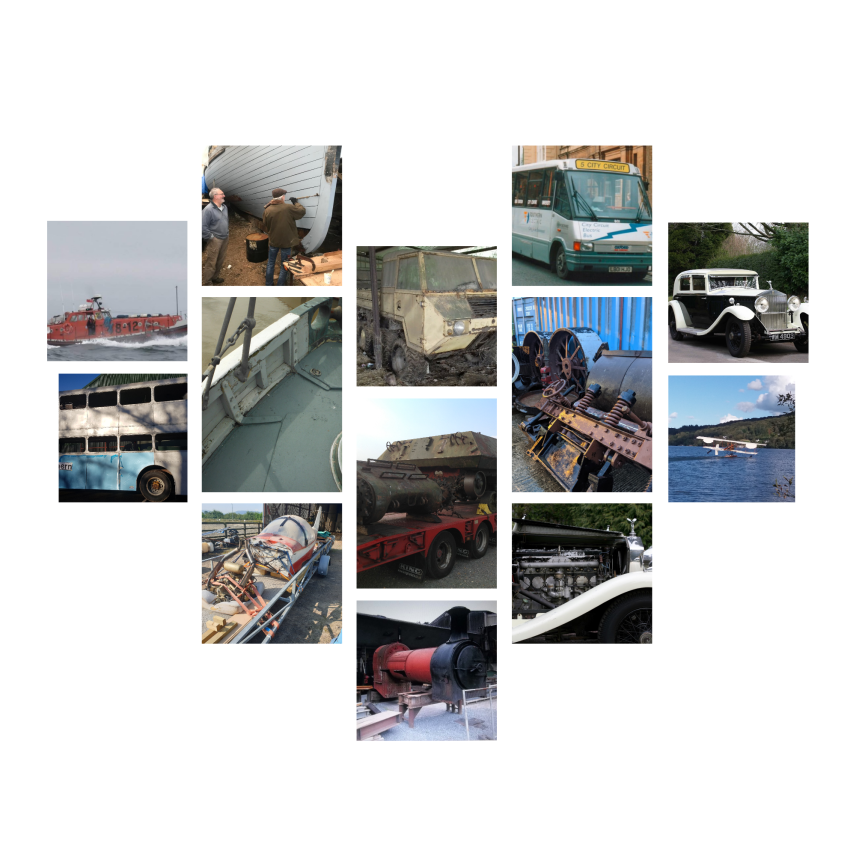
Commemorative Awards
The Peter Allen Award
Sir Peter Allen was the particularly influential first president of the Trust. The award in his name was this year awarded to the Britannia Sailing Trust for its restoration of the 1915 East Coast Sailing Smack " Britannia".
The Britannia Sailing Trust - 1915 East Coast Sailing Smack "Britannia"
The Brittania Trust was set up in 2013 to rescue and restore the 106 year old gaff rigged cutter, Britannia. In 2018 she was transported overland from Cornwall to the village of Winkleigh, mid-Devon and the project will take Britannia from her present condition - a bare hull - to a seaworthy vessel where she will then be operated as a sail training and heritage education vessel for public benefit.
Britannia is the last working example of her kind (Class One East Coast Smack). Launched in 1915, Britannia was the largest, and the last, east coast whelking smack ever to come out of Friar's yard in King's Lynn. Britannia was hand crafted by royal boat builders, who constructed her using timber chosen specifically from ancient oaks in Sandringham forest; the 400 year old timbers remain intact within her hull today.
Britannia's team have stabilised the hull and undertaken significant and much-needed repairs using time-honoured methods. By using like-for-like, hard to come by timbers of quality, well-seasoned wood of the correct species, as well as traditional tools, materials and techniques, Britannia is being returned as close as is practicable to her original specification.
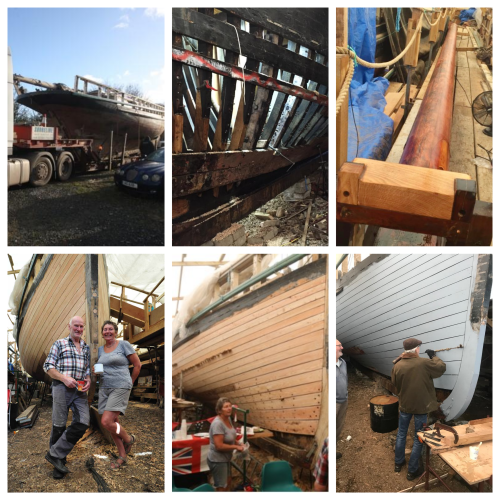 Britannia is a unique piece of maritime heritage and her restoration represents the culmination of a lifetime of boat-building knowledge and experience on the part of our project leader, who has sacrificed the better part of his retirement to see the project through to completion, ensuring that Britannia rules the waves for another 106 years.
Britannia is a unique piece of maritime heritage and her restoration represents the culmination of a lifetime of boat-building knowledge and experience on the part of our project leader, who has sacrificed the better part of his retirement to see the project through to completion, ensuring that Britannia rules the waves for another 106 years.
This is an outstanding effort being undertaken by a whole range of people led by some very dedicated individuals and the National Transport Trust is delighted to select the project for an award which was collected by Vicky Samuel.
The Sir William McAlpine Award
This year, the Linnet Project has been awarded the Sir William McAlpine Award. Introduced as new award last year, this award commemorates the great preservationist and transport heritage enthusiast and former Trust president.
The Linnet Project - 1964 Fairtravel Linnet Light Aircraft
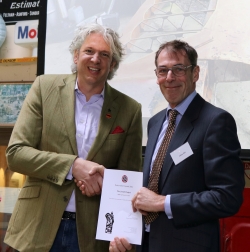
The objective of this project is to rebuild a vintage aircraft with local young people aged 14 to 21, to flying condition. The Project organisers aim to be able to fly it at air displays and shows. The aeroplane is constructed from wood and doped linen (fabric covering) and powered by an 0200 Rolls-Royce engine.
The aircraft was constructed in 1964 by Fairtravel Limited at Blackbushe Airport where the Horsa Glider was built and tested. This was the last Linnet that was made out of only 5 in total. There are only 2 surviving planes, one flying, and this one.
The aircraft has been dismantled, brought to site and placed in a suitable purpose-made workshop. The aircraft parts have been assessed for serviceability. A team has been assembled and DBS checked with volunteers from the Rotary Club, the Scouts, the Middlesbrough Tools Workshop Charity, 3 STEM Ambassadors and the Project Founder, who is a pilot and experienced aircraft builder. The project also has the support of the local LAA Inspector as well as The Light Aircraft Association and The Vintage Aircraft Club who are happy to promote the project and offer Engineering support.
The team have had enthusiastic offers of collaboration from the local secondary school science department and the local university and now need to select suitable candidates and supervising teachers. The first 10 introductory skills training sessions and assessments have been planned.
Following that, the 3 main steps are:
Step 1 : Clean the fuselage and make repairs where required. Recover the fuselage.
Step 2: Repair the main wing and cover it.
Step 3: Rebuild the engine.
This is an extremely unusual project, hoping to restore a rare British-built vintage aircraft to flying condition. Further, this excellent project will inspire and encourage the next generation of young engineers, flight enthusiasts and restorers to give them a unique opportunity to develop their skills and confidence, and the chance to see the project they have worked on actually fly!
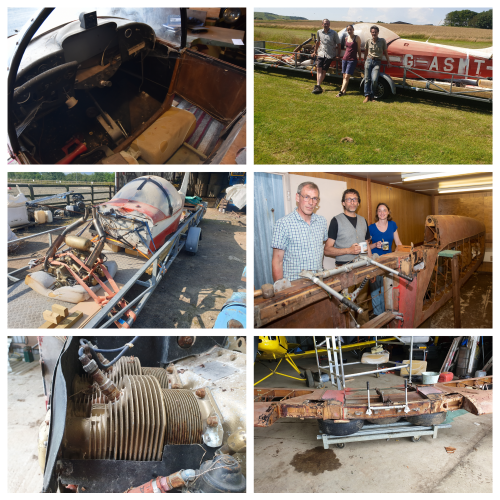
The awards panel were most impressed with both the aims of the project, progress thus far and particularly the enngagement of younger people representing the next generation of restoration enthusiasts. The TRust took great pleasure in having the project leader Julian Hill on hand to receive a well deserved award.
The Alan Moore Award
The Alan Moore Award commemorates his generous support to the National Transport Trust over the years and was this year awarded toThe Worcester Locomotive Society for their restoration of the 0-6-0 Kitson Locomotive 5474 "Carnarvon".
The Worcester Locomotive Society - 0-6-0 Kitson Locomotive 5474 "Carnarvon"
The project in hand is the restoration of a steam locomotive, Kitson 0-6-0 Saddle Tank, No. 5474 "Carnavon". The Worcester Locomotive Society has owned the engine since the late 1960s, but owing to lack of funds, it has not been steamed since the 1980s. The Society has a team of volunteers who spent about 1 weekend a month (prior to Covid) working on this and other restoration projects on railway rolling stock which the Society has acquired.
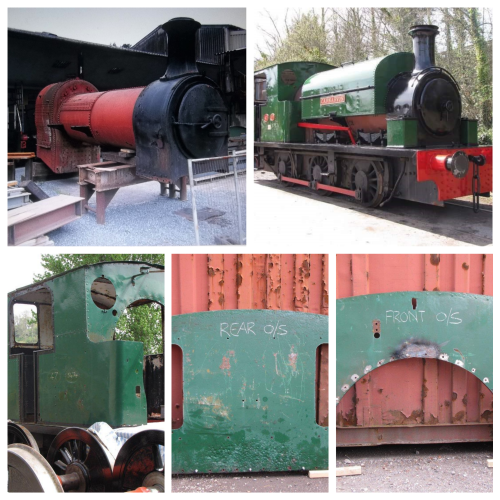
Restoration of the Kitson has been an ongoing project over many years, initially through preventative maintenance to avoid deterioration, and more recently, following some generous legacies from former members, and careful management of the finances, restoration has begun in earnest, employin volunteer labour wherever possible.
The major element of restoration is the steam boiler, which had to be outsourced, but is now being worked on by South Devon Railway Engineering. When this is complete, the steam locomotive will be reassembled, and join the locomotive fleet on the South Devon Railway, and will also be hired out to other Heritage Railways.
Only 3 of this type survive, and this will be the only one in steam. The National Railway Museum have a preserved example, but only as a static model. It is unusual in that it has independently sprung axles to allow for working on rough track such as quarries etc.
A new saddle tank has been fabricated and the wheels have been re-tyred. Steel has been acquired for the cab. The boiler has been dismantled for inspection and restoration. A Steam brake has been acquired so that the locomotive can be used for passenger transport on preserved railways. All other working parts are being steadily dismantled, repaired, refurbished ready for refitting
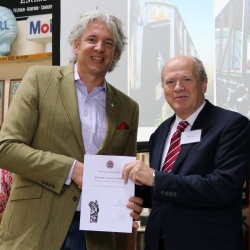
It will be only Kitson locomotive in steam, and the intention is to hire it to other preserved railways so that the public can see part of our industrial railway heritage which has all but disappeared. It gave the Trust great pleasure therefore to recognise this effort with an award and invited Chris Pate to receive it on behalf of the society.
The Ron Wilsdon Award
Ron Wilsdon Award is given in memory of the Transport Trust's founder and was awarded to Mike Mulford for the restoration of the Rolls Royce Phantom 2 Continental
Mike Mulford - Rolls Royce Phantom 2 Continental
This project is the restoration of a 1931 Barker bodied Rolls Royce Phantom 2 Continental. Displayed at the 1931 Olympia motor show, the car was originally purchased by John Moores, founder of Littlewoods football pools, who kept the car until 1937. It changed hands a number of times thereafter but one notable owner was the actress Diana Dors who purchased the car aged 21. A subsequent owner exported the vehicle to Honolulu before it was eventually repatriated in 1998.
The current owner saw the car for sale at Beaulieu in 2006 and was immediately attracted to its unique design, history and originality, despite the paintwork and interior trim being past oily rag
condition.
However, it was in running order so after routine servicing and a few essential jobs such as a magneto overhaul, the car was used for several years just as purchased, attending various RREC and other meetings where it attracted many favourable comments regarding the unique design and un-restored condition. This period allowed for a thorough appraisal of what would need doing to conserve the car for the future.
In 2015 it was decided to commence the conservation and restoration. The key objective was to only restore those parts which were beyond conservation - mainly the paintwork and interior trim. All other items, including the whole chassis would be serviced, overhauled, repaired or rebuilt as required, just as if it had gone back to the Rolls-Royce factory in the day for a routine major overhaul.
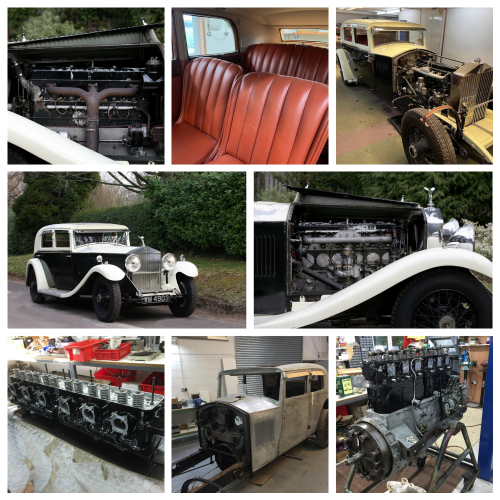
This has been a very personal project and the owner has wanted to do much of the work himself. The car has an interesting and colourful history and researching this has been an important part of the project.
This is a beautiful restoration of a most interesting car, and the National Transport Trust was delighted to be able to include it in this year's award line up, with owner and restorer Mike Mulford coming forward to receive it.
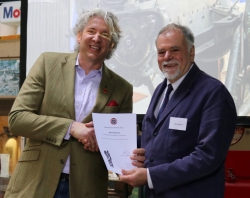
The Inaugural Bremont Special Recognition Award 2022
The Bremont Award has been made this year for the first time and is given for exceptional achievement. It is sponsored by Bremont Chronometers, the foremost watchmakers in Britain.
The Inaugural Bremont Special Recognition Award 2022 has been awarded to Ian Gee and the Waterbird Project Team In recognition of the successful construction and flight of the replica of the 1911 Waterbird seaplane.
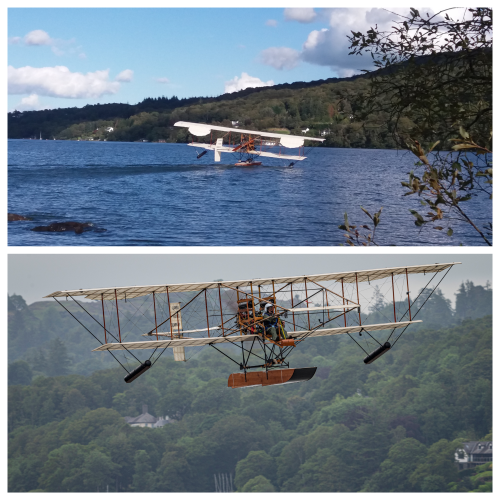
The first seaplane to fly in the UK, commissioned by Captain Edward Wakefield from A.V.Roe, made her maiden flight from Lake Windermere on 25th September 1911. Despite opposition from Beatrix Potter, opposed to noisy flights, the project was supported by the government but sadly the first Waterbird was destroyed when the hangar collapsed.
Following the discovery of blue prints in the Wakefield archives, the Lakes Flying Company was set up 13 years ago with the idea of building a replica. Gerry Cooper started the project by building a landplane replica and 10 years ago Ian Gee took over the project and work began to build the seaplane, supported by the Light Aircraft Association.
Following the issue of the LAA Permit to Fly, the work of this dedicated team came to fruition in 2022. Having been launched from a slipway from a temporary hangar on the west shoreline of Lake Windermere, on 23rd September the replica flew her first public flight in the capable hands of pilot Pete Kynsey. The press and public were further along the shore while the team watched the launch and flight. Cheers could be heard along the bankside as she took to the air!
Now the Waterbird is back in storage in Liverpool, Ian Gee and the team are looking for permanent premises on Lake Windermere where this unique aircraft can be seen by the public and make occasional flights to celebrate her rebirth. Congratulations to Ian and the team for their dedication to the project.
Restoration Awards
This Restoration Award was made to The Charles Henry Experience based at the Royal Quays Marina, North Shields Tyne and Wear for its project to restore the 1968 RNLI Oakley Class lifeboat "Charles Henry".
This aims of this project are threefold - firstly, to preserve for the public benefit the The Charles Henry, the only Oakley Class 48 class lifeboat afloat, and an historic vessel registered with National Historic Ships UK; secondly to advance the education of the public in seamanship, navigation, all aspects of small boat operations, in particular by providing an operational platform for Merchant Navy Officer Cadets to receive practical hands on experience in these areas that can be gained by planning and executing a voyage at sea and thirdly advance young people in life by maintaining The Charles Henry as a resource that can be made available to organisations including but not limited to Scouts, Guides, Sea Scouts, Army, Navy and Air-Force cadet groups.
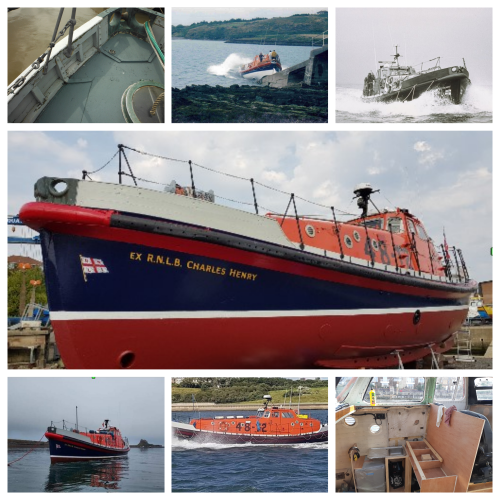
The "Charles Henry is the only Oakley Class 48 class lifeboat afloat. Originally there were 5 boats, the others were either broken up or have not been seen for many years. The present owner of 48-12 has returned the Charles Henry to operational condition having attained MCA Small Commercial Craft code 3 (up to 20 miles from safe haven).
Maintaining the Charles Henry at the MCA Small Commercial Craft, including the maintenance of all safety equipment, engines, navigation and communication equipment to the standard required is a never ending task and the National Transport Trust is delighted to be able to recognise the sterling effort involved for an award. Unfortunately none of the team could attend on the day but are nevertheless congratulated for their efforts.
Nick Steggel -1985 Esarco 8x8
The Esarco 8x8 concept was for a a low ground pressure multi-wheeled vehicle based on Land Rover components capable of carrying 2 tons across boggy terrain. The vehicle was designed by Major Michael Somerton-Rayner, who was also quite well known in air racing communities as well as being known for flying 7,000 miles from Malaya to Hampshire with his wife. This ties the importance of these vehicles not only to the Land Rover and military communities but also to the aircraft community. This early example, a prototype built in the 1980s, is believed to have been used for press photographs, and is the only known VM diesel prototype remaining.
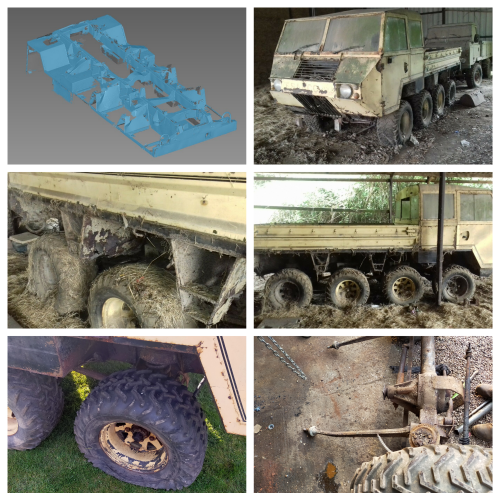
After the press launch it was used on Cromer beach carrying concrete sea defences but the salty conditions caused considerable damage to the hull and running gear. It then spent over 20 years in a barn until the current owner purchased it and commenced the restoration. The clutch and differentials were unseized within 24 hours of bringing it home and but it was soon discovered that the chassis corrosion was too extensive to just patch and preserve so instead a full strip down was commenced; the chassis has now been 3D scanned and shot blasted.
There are approximately 5-6 of the 8x8 Esarco prototypes remaining across the world and a couple of the 6x6 variants. Each of these is unique as they all have alterations to drivetrain and bodywork, even this example shows signs of alterations and development work. This Esarco, No 8 in the prototype run, is the only 3.6l VM turbo diesel Esarco known to exist.
This is a fascinationg, if somewhat quirky, example of British engineering Ingenuity and problem solving. In addition the restoration team are using up-to-the-minute technologies, such as 3d scanning, to assist with repairs, and have established a YouTube channel where all their restoration efforts can be seen by an ever increasing global audience. This combination of a desire to see an unusual piece of mobile heritage restored and displayed whilst at the same time leveraging modern technologies and techniques makes this a worthy award winner and with proud mum and dad in attendance watching, Nick Steggel was on hand to receive it.
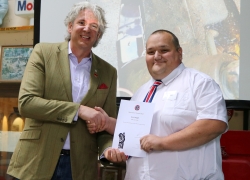
.
The current owner and his brother acquired this bus in 2008. It was almost derelict, having sat outside in Aberdeenshire for 25 years. The bus was originally local to their home town of Dundee. It is their intention to restore into the livery it carried in the 1970s.
W. Alexander (Falkirk) had 102 of these Leyland PD3s, all with Alexander bodies. This bus, KWG 655 (Fleet No. RB 194), is the sole survivor of those.
To date, the brothers have reinstated the platform at the rear, replaced the exhaust, and front wings, repaired the brakes, paint stripped the exterior, sourced a new front, removed the windows, bought new window rubbers, removed the seats for refurbishing, fitted new tyres, fitted a new water pump, reinstated the stairs to the upper deck, replaced some flooring on the upper deck, and currently paint stripping the interior in preparation for repainting, rewired the exterior lights. The next steps will be to paint the interior, and then purchase foam, and vinyl for refurbishing the seats. When the seats have been refitted, the bus will be ready for exterior painting.
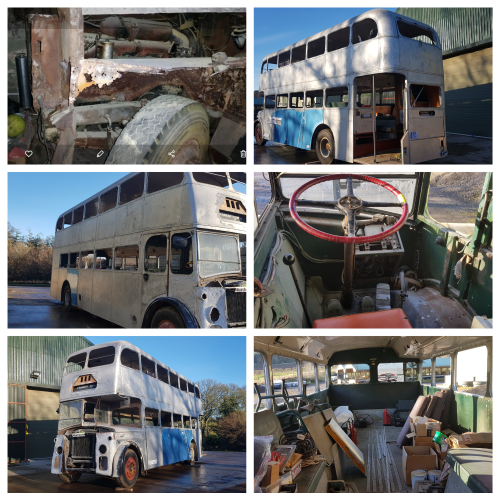
The amount of work involved in a restoration such as this is extraordinary, yet the team are taking everything completely in their stride and doing a fantastic job with the sole survivor of what, at one time, would have been a common sight in and around Dundee.
Unfortunately neither Mike nor his brother could be at the ceremony to receive this well deserved award, but they are to be congratulated and the trust wishes them well getting the project finished.
Mark Robinson - M10 Achilles Tank Destroyer
This project involves the ground-up restoration of a 1943 M10 Achilles tank destroyer used by the British Army in World War II. During this war, the British Army sought to reinforce its armoured fleet, and required armoured vehicles that they did not have at the time. The M10 Achilles tank destroyer comprised an American hull and running gear, and as well as supporting allied troops in many other ways, was fitted with the British 17 pounder gun which was capable of defeating the German Tiger 1 tank.
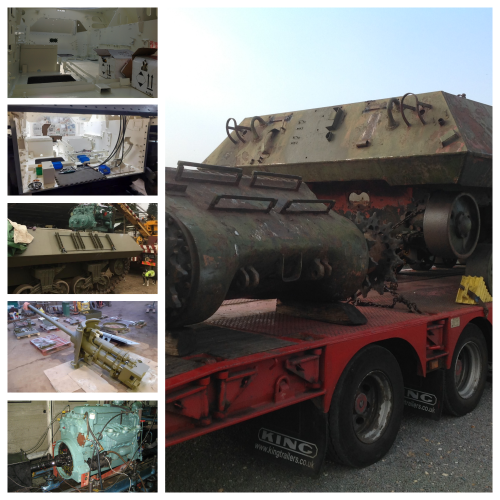
The hull has been stripped and sandblasted and the engine has been rebuilt and put back in the completed hull, although many other items and systems still need to be fitted and commissioned. Hundreds of parts have been removed, fixed, sand blasted and painted before being replaced, and missing parts are having to be fabricated from scratch.
The tank is a great piece of British and allied history from World War II. The owner and restorer is a regular attendee at military shows and events all over the UK and intends taking the Achilles with him. A running, working M10 Achilles in the UK is quite a rarity and it is with much pleasure that the National Transport Trust can assist with a restoration award.
The effort and attention to detail that has gone into this project has been exceptional, and it is well deserving of a restoration award, and owner, Mark Robinson, was on hand to collect it.
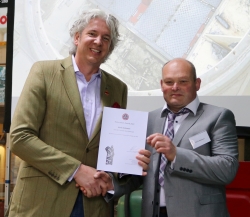
The Oxford Bus Museum - Restoration of Oxford's First Electric Bus
The project is the completion to exhibition standard of one of the UK's first electric buses. It has an association with Oxford, being one the first of 4 such buses operated for 6 years in Oxford to assess the viability of electric buses, with charging points at the depot and at the station terminus. Although a far cry from the "fast charge" electric buses now entering service at the time these represented a significant leap in technology to reduce dependence on oil and improve air quality. They were trialled there in 1993 in a joint enterprise between the Oxford Bus Company, Southern Electric and Oxfordshire County Council.
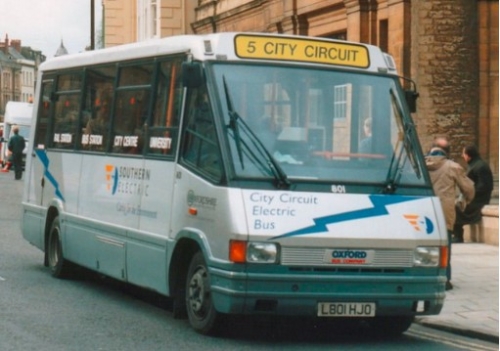
After funding for the experiment was discontinued in 1998 the buses went on to see further service in Jersey, but only until the end of 1999, after which they were dispersed.
The subject of this project ended with Moray Council, which offered it to the Oxford Bus Museum so that it could return "home" and be displayed to the public. It was hoped that the bus could be kept in running order, but expert advice has been obtained from those who most recently worked on the bus, and they say that it is imperative that the batteries should be charged and discharged on a regular basis - at least twice a week. Sadly it is currently impracticable for the museum to run the bus twice a week. But it is being returned to its original Oxford
livery: this has involved repainting and manufacture and application of the promotional vinyls it displayed when the bus was in service in Oxford. It will then be a complete representation of Oxford's first electric bus.
By its nature the bus is unique. Although electric buses are ubiquitous today, 30 years ago they were a total innovation. Oxford has, with Coventry, recently been selected as one of the first cities to have all electric buses, so this restoration is highly topical and admirably illustrates the "then and now" of such technology.
The Oxford Bus Museum has done a great job in preserving many vehicles, of which this is but one, but even so it is both interesting and unusual, and we are delighted to recognise the effort. The Trust was delighted to invite Chris Butterfield to step forward and, on the museum's behalf, accept the award.
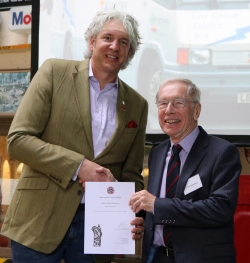
Sam Booth & John Edward Rex - 1921 Ruthmeyer Steam Roller
This is a 1921 Ruthemeyer steam roller that was purchased entirely in pieces. The aim is to restore this steam roller to its former glory and to the best quality possible.
The steam roller has a massive amount of history. It is a German steam roller so isn't held in high regard in some people's eyes. However, the project team holds lots of original documentation including details of the boiler at the production stage in 1921, letters to the company in Holland stating its delivery date and its original bill of sale, the entire steam test record from 1921 until 1968, countless photographs of the engine in Dutch books and also a book written about the company that owned the roller. As it was the first steam roller that company purchased, it was restored and kept on a plinth outside their offices until 2013 when the company went bankrupt.
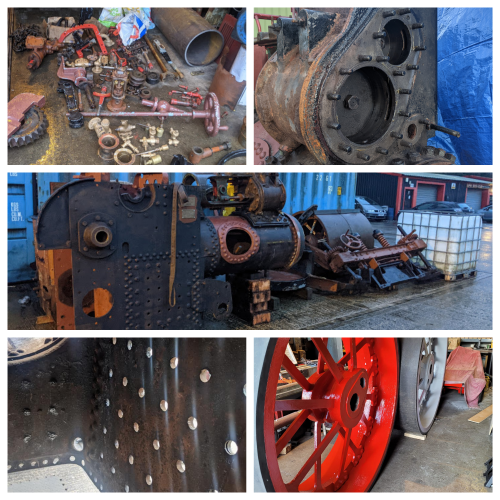
After the sale of the company, the engine was sold at auction and moved to a warehouse in Holland where it was stripped, but no work had been undertaken until it was purchased by the current owners. The firebox was condemned by the boiler inspector, so that was removed over 4 Saturdays. Happily, with the company that the owner works for being coded for making miniature steam boilers, the owners will be making the firebox themselves having already obtained a Lloyd's approved design. The rest of the parts are all there and just require cleaning and painting/polishing/servicing where necessary. All bearings are in great condition.
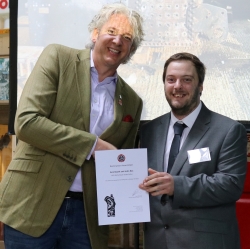
With a vast amount of known history, and enthusiastic and knowledgeable owners, this unusual engine, once completed, is bound to attract significant public interest at shows around the country and fully deserves a National Transport Trust restoration award, which co-owner Sam Booth was present to collect.
The National Transport Trust makes loans to groups, associations and individuals at advantageous rates for the restoration of artefacts - whether mobile or part of the infrastructure. Applications must be supported by a simple business plan which demonstrates the financial viability of the project. A sample business plan is available on request from the Treasurer.
The Trust does occasionaly make Awards for schemes which further the preservation movement. Again if you wish further information please contact the Treasurer.